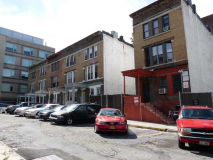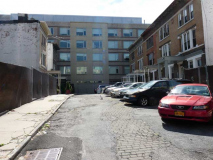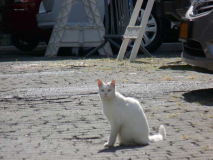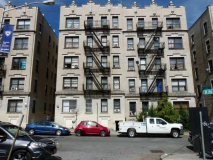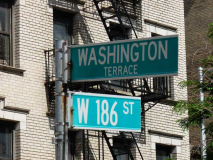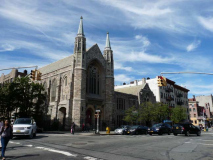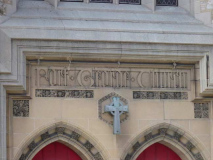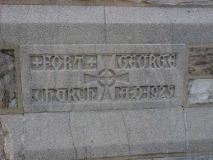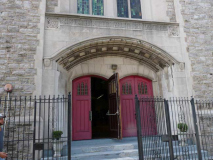On a crystal clear day in September, I took the A train like Ellington uptown to the 145th Street station and started idly milling about the upper Manhattan neighborhoods of Hamilton and Washington Heights, named for the country’s first Treasurer Alexander Hamilton, who built a house here that still stands, albeit after several moves, and General, later President George Washington, all of whose battles with the British in what would come to be Greater New York came down to strategic retreats; here was no different, as theBattle of Fort Washington‘s conclusion left the city in the hands of the Brits, who would hold it with an iron fist until 1883′s Evacuation Day.
GOOGLE MAP: Hamilton and Washington Heights Walk
When I left you I was at Yeshiva University at Amsterdam Avenue and West 186th, and decided to walk west on 186th to encounter a Forgotten NY enclave no one takes much notice of but me, and its few residents…
Washington Terrace is a dead-end between Amsterdam and Audubon Avenues. Most such alleys in upper Manhattan and the Bronx were real-estate developments. The land was purchased in 1898 by Bayonne builder Daniel J. Murphy, who built 18 modest brick dwellings with exterior porches that were completed by 1900. Murphy had to foreclose on his properties after that, but continued to live at #18 Washington Terrace. (Since so many other streets in NYC are named ‘Washington’ you wonder why it wasn’t called ‘Murphy Terrace’ but we can imagine he was of a patriotic bent.) In the 1980s five of the homes were abandoned and the terrace became an eyesore, but it seems to have stabilized since then.
A pair of churches in Washington Heights caught my attention. Fort George Church, West 186th at St. Nicholas Avenue, was named for a fort erected by the British and named for George III in 1776 in today’s Fort George Park at Audubon and Fort George Avenues. Between 1895 and 1914 it was the site of the Fort George Amusement Park and is today the site of George Washington High School. The tunnel exit of the #1 train at Dyckmen street is also marked “Fort George.”
The Presbyterian church named for it was established in 1916 at 564 West 185th Street, while the present handsome twin-spired stone edifice was built between 1925 and 1927.
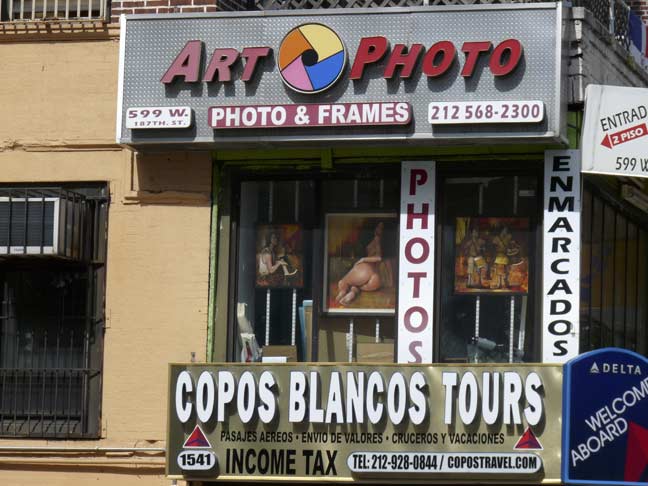
Some art photos at St. Nicholas Avenue and West 187th.
I liked this grouping of attached brick homes with pediments at the front entrances on West 187th west of St. Nicholas Avenue, allowing residents to fumble for keys out of the rain. These are typically found in the other four boroughs, but not in Manhattan.
This part of Washington Heights is quite hilly, the hilliest area in on the island of Manhattan. There was a great deal of corrugation left over from retreating glaciers during the last Ice Age. Only W. 181st Street, which runs from the Washington Bridge west to Riverside Drive, is the only east-west street to span this part of the island. W. 187th comes the closest, but it’s reduced to a step street from Overlook Terrace to Fort Washington Avenue.
St. Elzabeth’s parish is one of Manhattan’s oldest: it was established in 1869 when most of the surrounding area was vacant (I don’t know how much farming could be done on the steep hills and rocky terrain) when Broadway was still known as Kingsbridge Road. After the original church, designed by Nicholas LeBrun burned down in 1925, the present Neo-Gothic stone church’s cornerstone [Robert Reiley, arch.] was laid in 1927, with the nearby school from the same period.
The hill on West 187th between Wadsworth Avenue and Broadway is likely the steepest on the island open to traffic.
I’ve been fascinated with this trio of freestanding (but attached) houses on the block since I “discovered” them. Frame houses like this have become increasingly rare in Manhattan, where most buildings are multiunits, office buildings, commercial buildings, schools, etc. I got three photos from 3 different angles.
Unfortunately there seems to have been a recent fire [October 2014] and only the center house seems habitable at this time. I imagine they’re awaiting the wreckers now.
Looking up the West 187th Street hill from Broadway. St. Elizabeth’s Church stands at the hillcrest on the right.
The AIA Guide to Manhattan doesn’t pay much attention to Washington Heights at all. Thus, I know virtually nothing about the quartet of handsome brick apartment houses on Broadway opposite West 189th Street, just south of Gorman Park.
There is a handsome enamel “apartments available” sign by one of the front entrances. These signs are most often in red or green with gold accents, and announced the size of the apartments for rent inside. Most often they are found in upper Manhattan and the Bronx though I’ve seen a few in Brooklyn.
As it happens there’s another example just across the street at Broadway and West 189th. Same color scheme, but rectangular instead of oval. I’m always drawn to take pictures of them, they’re so handsomely produced.
Hard to imagine, but I had never been past West 189th Street and Bennett Avenue, a block west of Broadway before, and so had missed out on the Cornerstone Center at #178 Bennett, which houses Our Saviour’s Atonement Lutheran Church and the Northern Manhattan Arts Alliance.
OSA is the product of the 1927 merger of two older churches, the Evangelical Lutheran Church of the Atonement, and the Lutheran Church of Our Saviour. The cornerstone for the stone parish house was laid in 1927 along the side of one of Manhattan’s highest rises of gneiss bedrock, and seems to complement its natural surroundings excellently. Plans for a hospital and sanctuary fell victim to the Depression, but in the 1970s the parish house was rebranded the Cornerstone Center and added a video studio, dance and performance space, a kindergarten, and a church for the deaf. A Reform Jewish congregation, Beth Am, also shares the facility.
Looking north along Bennett Avenue. The exposed rockface is starker in the winter, without all the foliage; masses of ice during snowy, cold weather decorate the crevasses.
For the most part, most Independence Subway stations were interchangeable as far as decor is concerned. The line was built by the city between 1925 and 1950 and all the stations were designed to look just about the same, except for different color tiles on the station ID plaques.
Occasionally, though, topography conspired to throw the IND “off track.” The F train in Gowanus rises close to 90 feet over the noisome and noxious namesake canal, forcing the IND aboveground for two stations, while here in the northern end of Washington Heights at the 190th Street station, city engineers had to build a tunnel though a mini-mountain in order to build an entrance from Bennett Avenue. The line actually runs under Fort Washington Avenue.
It is indeed a lengthy tunnel, unadorned with decorative tiling, ads, fancy lighting or anything else that would have cost extra $$$.
The IND 8th Avenue 181st, 190th and 200th/Dyckman Street stations all share a decor element not found elsewhere in the Independent system: arches on the side walls with short station ID plaques interspersed between the arches. It’s a unique look.
11/9/14

